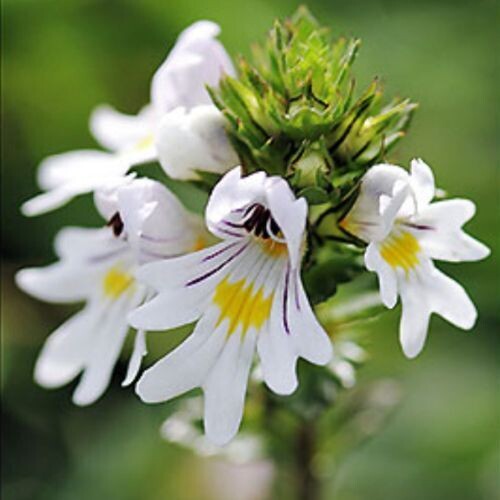Eyebright (Euphrasia spp.)
Available as cut dried herb and herbal tincture.
Please note this is a nutritional, functional horse food supplement and not veterinary medicine.
See Dr Kellon's Horse Sense - 'Nutrition is not 'Alternative' Therapy.
Tincture
Our human-grade, certified organic tinctures give you a ready-to-absorb potent source of phytonutrients at the highest-strength available, for immediate absorption straight into the bloodstream and to the body’s cells.
100% certified organic pure tincture: Euphrasia officinalis (Eyebright) Herb, Infused 1:3 25%, Organic Cultivated
Feed Guide
- Horse - 30-40ml / Pony - 15-20ml, daily in feed.
- Always shake the bottle to disperse any sediment.
- 3-year shelf-life.
Dried Herb
Produced to ecological standards and free from agro-chemicals.
Certified organic dried herb: Euphrasia officinalis (Eyebright) Herb , Organic Cultivated , Origin E.Europe
Feed Guide
- 5g/100kg bodyweight per day, thus for an average 500kg horse add 25g daily to feed.
- 1-year shelf-life.
Functional Nutritional Value
Constituents: Iridoid glycosides (aucubin, catalpol, euphroside, ixoroside), lignins, flavonoids (quercetin, apigenin glycosides), flavonoids, alkaloids, tannins, volatile oils.
NB. Our range of botanicals are all grown, harvested and dried without the use of agri-chemicals, non-irradiated and GMO free - see our Quality page for Quality Management & Certification Documents. Laboratory tested for identification and compliance to the British and European Pharmacopoeia standards, and are human grade. Please be aware that if you're purchasing our dried botanicals for human use, our dried range is cut to appropriate sizes for feeding to horses.
More ...
Nearly every piece of information about eyebright, from ancient to new, has to do with vision, the eyes, and the sinuses. Peripheral uses, which may not be mentioned in every source, also include applications for the head, such as historic claims of use for vertigo and epilepsy.
You'll read that the 17 century herbalist Nicholas Culpeper claimed that it promoted memory and recorded it as a remedy for vertigo, which may connect to its uses for inflammation and catarrh in the eustachian tube. He also wrote that if its use would be more widespread it would “half spoil the spectacle makers trade” ;-)
An ophthalmology textbook written by English physician Walter Bailey in 1586, called A Brief Treatise Touching the Preseruation of the Eie Sight , also described the use of eyebright against cataracts and to preserve eyesight.
According to herbalist and author Maud Grieve, eyebright was juiced for herbal use, and in Scotland, highlanders made a tea by steeping eyebright in hot milk, straining it and brushing it onto the eyes with a feather. And there are so many other citations including 'acute catarrhal inflammations of the nasal and ocular membranes, with profuse, watery secretion or abundant flow of acrid mucus, and attended with heat, pain, burning, and sneezing; useful for watery discharge, acute inflammation, and irritation of the eyes, sinuses, and ear. Felter emphasized its use in hay fever (Felter, 1922).
The Eclectic physician Finley Ellingtonwood and pharmacist John Uri Lloyd (1915) described the use of eyebright for the upper respiratory tract, mucous membranes of the throat, and bronchial tubes. Their text described its use for “snuffles” in infants and also adult use for irritation of the eye, ear, and especially when these symptoms occurred together.
Ellingwood believed eyebright had a specific affinity for the lacrimal glands (the tear ducts), and described the use of eyebright in chronic catarrh, and common eye irritations with catarrh, as well as some other conditions affecting the head.
It's also been used as a first aid remedy for livestock with eye afflictions, as cited in an ethnoveterinary study of use of herbs in ruminants in British Columbia (Lans, et al., 2007).
Modern day research has shown it's particular beneficial as an antioxidant, and having a mild stimulating, and astringent action that constricts the blood vessels of the nasal passages and the conjunctival (lachrymal) mucous membranes, helping dispel mucus and other exudates that result from inflammation” (Katz, 2000).
Allergic rhinitis, post-nasal drip, sinus headaches, sinusitis, otitis media, and red, itchy eyes associated with hay fever, coughs and sore throats, as well as topical use of homeopathic preparations for eye fatigue and conjunctivitis, are all noted (Kuhn & Winston, 2008).
Overall, modern phytochemical research supports that eyebright is helpful to the sinuses, and soothing during acute irritations of the eyes, supporting the traditional use as a first aid item in a compress or a wash.
An awesome little herb indeed :-).
The content in this website is intended as a sharing of knowledge and information from our own research over many years, together with clients' experiences and our own personal experience over 5-decades of horse care. This website is about enlightening towards a more naturopathic approach to support a healthy lifestyle for our horses. Any information contained within is not intended as a substitute or replacement of veterinary or other professional advice, and we would encourage everyone to make their own equine healthcare decisions based upon their own research.
* Trading Standards EC Feed Hygiene Regulation (183/2005), Registration No. GB280/4203
* HACCP certified facility (an international standard that ensures we meet food safety standards)
* Registered in England. Company Number 11075894, Reg'd Office: Unit 4 Rookery Farm, Radstock BA3 4UL
* VAT No. GB 310214964


